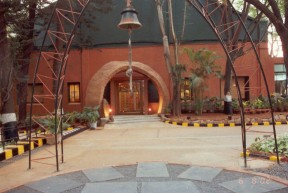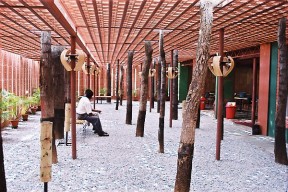One story that I read after an earthquake crippled Gujarat in 2001, has remained with me. It was about how a prosperous resident of a multi-storeyed apartment block in a city had violated construction rules and built a pool for himself on the common terrace. When the quake shook the building, the pool crashed with spectacular effect, taking everything that came in its way.
Compare this to Japan where the majority of the damage to the resilient structures was caused by the tsunami and not the earthquake.In India though, if we were to check how even renowned builders mess with safety specifications, it would be hard to feel safe indoors ever again. Few builders or home owners worry about natural disasters while they lavish attention not so much on the fundamentals but the extraneous frills. What we saw in Gujarat where entire towns became rubble in 2001 and are now seeing in the wake of the Japanese quake, must make us realise that we can no longer build randomly and have to stay within the larger context of the environment.
Historically, India’s architecture had a natural instinct for weather, for local design idioms and contextual materials. Every region in India had its own unique architectural vocabulary. Be it Hampi, Bijapur or Fatehpur Sikri, we built sensitive and sensible architecture. Not so any more. To borrow and tweak a famous observation, “Once we built civilisations, now we build shopping malls.”
Just take a look at Bangalore. In a city famous for its salubrious weather, we now have inward looking office buildings and malls with glass facades that trap heat and require intense air-conditioning to stay cool.Homes with monkey top windows, gardens and cross-ventilated rooms have been replaced by apartment blocks which not even in passing acknowledge the human need for intelligently designed living spaces.
Today, most structures use an excess of imported building materials and create a large carbon footprint. The construction waste that builders generate and dump indiscriminately pollutes water, air and lung spaces. We are learning at great human cost that Nature is not inexhaustible and unless we adopt building practices which are energy, material, site and climate sensitive, we will pay for it. We must ask ourselves what exactly are our architectural reference points? And if our buildings are in synergy with the planet?
Charles Correa in his book A Place in the Shade asked similar questions and the answers lie with architects (in India and abroad) who are reinterpreting building practices in a green vocabulary. Didi Contractor’s cost effective mud houses in Himachal Pradesh, Chitra Vishwanath’s ( BIOME Environmental Solutions) energy conserving, water and waste recycling geen roofed homes, Sanjay Prakash’s eco-sensitive structures, Biodivesity Conservation India (Private) Ltd (BCIL) conscientiously green community housing, Professor R Jaisim’s constant love-affair with light, earthy materials and organic living spaces show us that green can be cost-effective as well as aesthetic.
Surya Kakani in Ahmedabad, Professor KT Ravindran in Delhi and others like the iconic Balakrishna Doshi, Charles Correa, Laurie Baker and Raj Rewal have exemplified architectural integrity and a green sensibility in the Indian context.
In 2008, I had attended BuildArch, a conference at the Bangalore International Exhibition Centre (BIEC), where a session chairman commented that green architecture was not just a trend but must now become a standard requisite for every future building where concepts like zero waste, zero carbon emission, reduction of green house emissions and recycling are the norm rather than exceptions.
Nicolas Karl Hahn of Schuco (one of the world’s leading providers of solar energy technology) at the event had rubbed it in that in the tropical and sub-tropical Indian climate, the brand of architecture we see in Hong Kong or Dubai is not contextually correct. And that natural ventilating systems must be devised instead of using energy gobbling, mechanised weather management inside the buildings. Energy is becoming expensive the world over and alternatives must be found and soon.
A holistic approach to building will not just decrease energy cost but also have environmental, social and economic spin offs. Steel was talked about as a cost-effective, green building material with seismic reliability. Architect Neelam Majunath spoke about bamboo as a building material which grows fast, is stronger than wood or timber, cuts easily, is light and hollow, flexible and easily available. The least amount of energy is required to produce bamboo and it is the most sustainable and synergistic building material on earth. The cost of procuring it, transporting it and working with it is also low. Bamboo’s thermal connectivity is better than wood and it can be used to build bridges, homes, domes, grids, scaffoldings and much more. It exhibits stoic resistance during earthquakes and has excellent load bearing capacity.
But back to our messy cities. A few years ago, I met Wong Chiu Man, Managing Director of WOW Architects/Warner Wong Design, Singapore. He had designed a hotel in Bangalore and commented on how the Bangalore and many cities in India seem to have lost their way.Every building, he said, should emerge from a dialogue between the architect and the environment. But that cannot be seen in Bangalore anymore, he said and added that the systems are uncoordinated and slow in the city and only pragmatic and not populist governance with long term strategies can sort the bottle necks. What we build today will either enhance this planet or abuse it and if green architecture becomes a global movement, the earth will be a safer, cleaner place for the generations yet to come. And if we continue to mess with it, there really is no other home to go to.
Photographs: Courtesy Jaisim Fountainhead








A one hundred percent true! Unfortunately our ‘chalta hai’ ‘hota hai’ attitude percolates into everything…A day after the Japan earthquake, all houses and even high rises in Beijing and other Chinese cities were checked for the strength of their pillars! In our country, we don’t care. Even after Mumbai became the next Cherrapunji of India, we have not done much to look into the reclaimed lands, the lowlying plains where hutments continue to grow like wild creepers what now a local has learned to perceive as chrysanthemums…and I guess the Govt just waits for another flood to wash them away so they don’t have to get into relocating them to concrete houses. Let God take care of his creations, eh!
very true… we have no other home to go to. And the lessons and the knowledge have been around for centuries. Vaastu and Feng Shui have started to sound like so much hooey to the layman, simply because they have been invested with pointless frills and are being mutilated in the hands of unscruplous practitioners. In fact, these are ancient sciences pertaining to architecture and planning, to harness the energies of the environment an the elements to the best possible effect. The two, which have a lot in common, are simply expositions of the observed laws of nature and its forces, utilized in a manner that would harmonize the energies within and without, and result in enhancing the quality of life. We really do need to get back to our roots if we are to undo the damage we have inflicted upon the planet for the past so many generations!